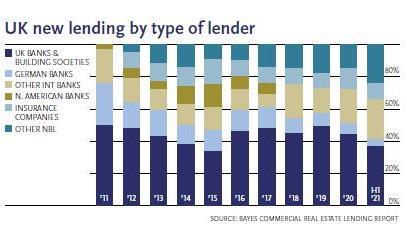UK lenders have been playing catch up in 2021, with backlogs of deals from 2020 boosting first-half lending figures.

The Bayes (formerly ‘Cass’) UK Commercial Real Estate mid-year report for lending activity in Q1 and Q2 2021 shows UK market volumes recovering to £23.3 bn (€27.4 bn) - up 50% on the same period in 2020.
The report, published last month, says: ‘While the first half of 2021 showed a rapid recovery of market activity, borrowers were looking to finalise, restructure and refinance loans that had been on hold during 2020. This accounted for 50% of lending, while the other 50% was new acquisition financing.’
This is likely to be a similar picture in other European jurisdictions. Speaking to PropertyEU at Expo Real in Munich in October, Helaba’s head of international lending, Michael Kröger, commented that the bank continues to see relatively fewer new financing opportunities in all markets than in pre-Covid times. But this decline is balanced by recycling existing loans on the book.
‘New business is not at the level of three to five years ago, but there is a lower repayment rate, so this trend is not detrimental to the P&L for banks’, he said.
One of Helaba’s 2021 transactions was financing the July acquisition of Windmill Green, a BREEAM ‘Outstanding’ office refurbishment in Manchester on behalf of Trinova Real Estate and Europi Property Group’s CityBee UK fund. But the Bayes report says that, generally, German banks have pulled back ‘substantially from the UK lending market given their long-term historic significance’.
Non-bank lenders
Another notable trend is that debt funds and insurance companies are filling this and other gaps as they continue to increase their market share versus banks.
The Bayes survey’s ‘other lenders’ category - which mainly comprises debt funds - was the second strongest lender group after UK banks, providing almost a quarter (24%) of new financing in the first half of 2021.
The number of fund managers moving into investing in property debt continues to gradually increase. Within the last 12 months, for example, both Tristan Capital and Kennedy Wilson have raised new capital for the asset class.
PropertyEU’s weekly data sheet, published every Friday, has logged 15 European debt fund launches already this year.
Insurance companies have also been steadily increasing lending. The report says debt funds and insurance companies have doubled their origination volume in the UK compared to 12 months ago and were the strongest originators.
Dr Nicole Lux, the report’s author, believes this is a sign of the UK lending market’s resilience and ability to evolve.
She says: ‘Lending activity was particularly resurgent among lenders with smaller balance sheets. In the first half of 2020, large balance sheet lenders still held a share of 59% of new origination.’ In H1 2021 this fell back to 35%, while ‘small to medium-sized balance sheet lenders accounted for 44% of new lending, with 45% of their lending used to refinance loans from other lenders.
‘This shows the market has been resilient and responding to changes in lending activity through different lender groups.’
Kröger said the market continued to show ‘cool, calm and collected behaviour’, while Peter Cosmetatos, chief executive of CREFC Europe, said that as Covid uncertainty gradually recedes, the Bayes report provided evidence ‘of a strong but sober recovery in lending’.
He added: ‘Debt funds seem to be stepping up their market importance, accounting for almost a quarter of new origination and shifting from mezzanine lending to whole loans, often enabled by back funding from the banking sector.
‘Also striking are the emerging sector preferences of different lender types, with UK banks favouring lending to residential over the prime offices still preferred by German banks and the higher yielding office financing provided by debt funds.’
Decline in average loan book quality
Non- or under-performing loans increased to £8.2 bn (9.3%) of UK loan books.
Unpaid principal and interest at maturity were one of the most frequently cited reasons for loan breaches and defaults.
There is a significant difference in loan book quality. Smaller lenders with books under £1 bn had a high average default rate of 11% compared with the 4.8% default rate of lenders with books over £5 bn. Smaller lenders also have higher average loan to values and lower interest coverage ratios than their bigger peers.










